Quick Summary:
Struggling with the complex data manipulation in Java? Enter Java Streams! A powerful API for processing data collections concisely. Learn how to filter, map, and reduce your data with ease, streamlining your java code and boosting its efficiency.
In this blog, we’re going to discuss📝
Ever feel like you’re spending more time wrestling with data than building elegant code in your Java applications? We’ve all been there. Filtering, updating, and summarizing collections can quickly become a repetitive task, resulting in verbatim code filled with potential errors. But what if there was a way to simplify this process? A way to write code that is concise, readable, and can be fast?
Enter Java Streams – a powerful and elegant API introduced in Java 8 that streamlines the data processing. Java Streams offers a concise and functional approach, making your code more readable, maintainable and potentially more performant.
This blog post shares insight on unlocking the potential of Java Streams. We’ll delve into the core concepts, explore essential operations like filtering, mapping, reduction and showcase practical examples that demonstrates the power and expressiveness of Streams.
Let’s begin with the having overview of Java Streams and their features.
What are the Java Streams?
Java Streams are a powerful abstraction introduced in Java 8 that enables functional-style operations on sequences of elements, such as collections or arrays. Streams provides a concise and expressive way to perform bulk operations, such as filtering, mapping, and reducing on data sets.
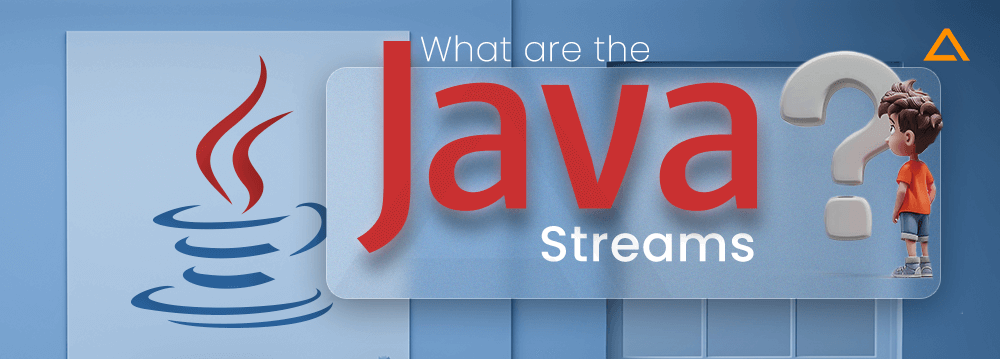
Let’s understand it better with the example:
Imagine you have a giant bag filled with different colored marbles. Traditionally (without streams), you might have to sort through them one by one find the blue ones(filtering) and then maybe paint them all gold (transforming). This can be cumbersome and error-prone.
Remember, Java Streams offers a more streamlined approach. They act like an assembly line for your data. You can:
- Filter the marbles: Instead of manually picking out the blue ones, you can define a rule for the stream to only consider blue marbles.
- Transform the marbles: The stream can take all the blue marbles and paint them golden as they move down the line.
- Summarize the marbles: In the end, you can easily count how many gold marbles you have (which were originally blue).
Streams provides a more concise and readable way to achieve these tasks, and more often with the optimized performance. They are like a god send gift for any java developers working with the collection of data.
Features of Java Streams
Java Streams go beyond just a fancy name for data processing. Let’s explore some of the important core features that makes Java Streams beneficial:
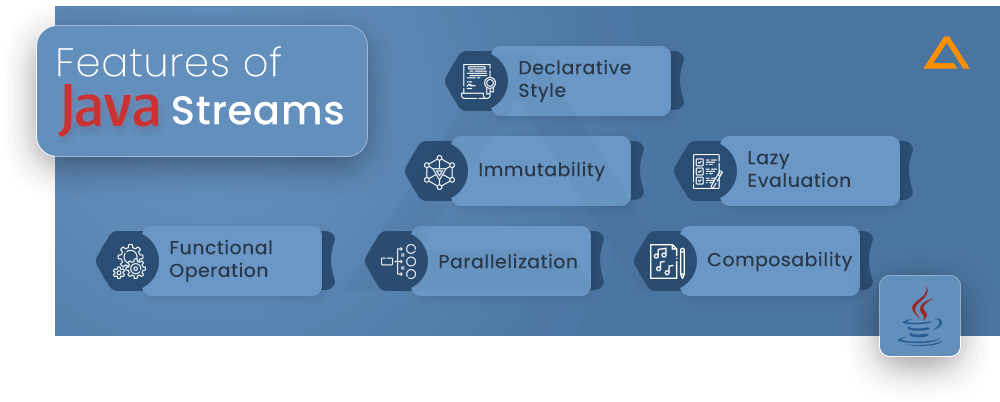
- Declarative Style
- Immutability
- Lazy Evaluation
- Functional Operation
- Parallelization
- Composability
By understanding & utilizing these features effectively, you can unlock the full potential of Java Stream and write more efficient, maintainable and faster code of your Java applications.
Why Use Java Streams?
Java Stream provides number of benefits for various scenarios, where you need to manipulate data collections in a concise and efficient manner. Here is the situations where Java Stream excels:

Write less, do more
Java streams provide concise data using `map`, `filter`, and `flatMap`.
Quickly find what you need
Stream filtering allows you to better target specific content.
Less code, more clarity
Built-in aggregation methods (sum, min, max) mitigate boilerplate rules.
Speed up for large data (optional)
Use parallel processing for maximum performance gains on large data sets.
Clean and readable code
Focus on the “what” to do, not the “how” of the advertising process.
Phases of Java Stream
A Java Stream is composed by three phases:
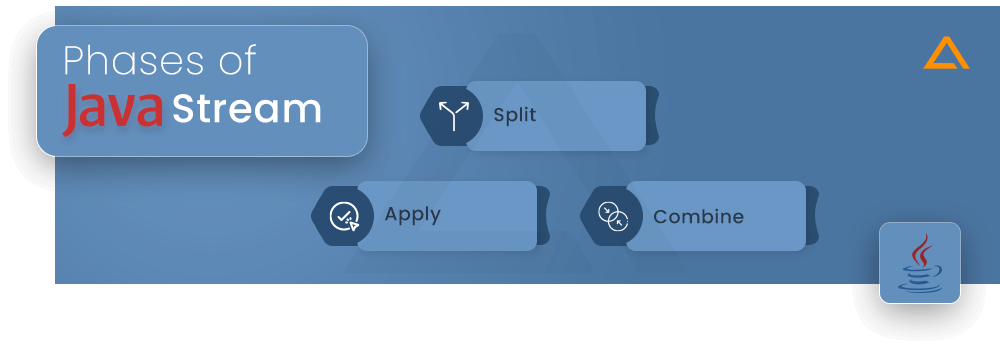
Split
For instance, data is gathered from a channel, a generating function, or a collection. To handle our data, we convert a data source, also known as a stream source, in this phase.
Apply
Every component in the sequence is subjected to every pipeline action. Intermediary operations are those that take place during this phase.
Combine
Completion with the terminal operation where the stream gets materialised.
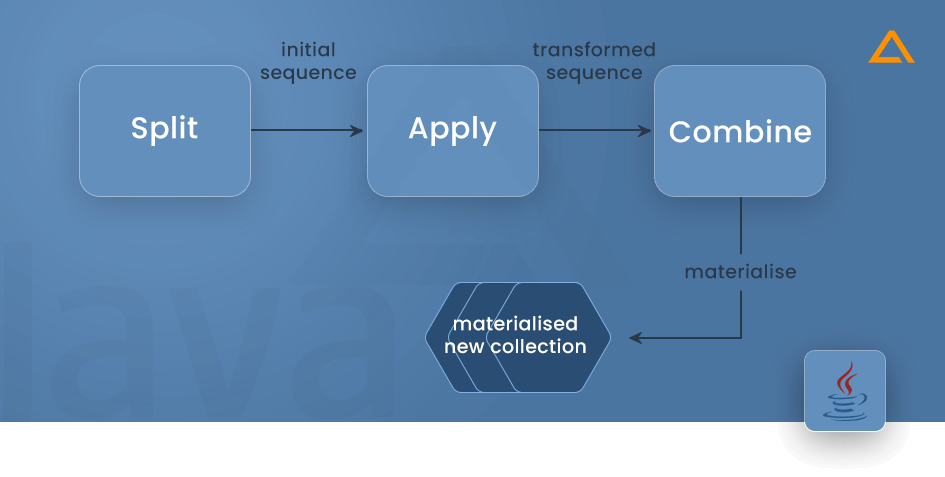
Please remember that when we define a stream, we are only declaring the steps to be followed in our work pipeline, they will not be executed until we call our terminal operation.
Core Operation of Java Streams
Java Streams provide a powerful toolbox for manipulating collections of data. But what are the essential operations that make them tick? Let’s explore the basic functions that underpin Stream functionality:
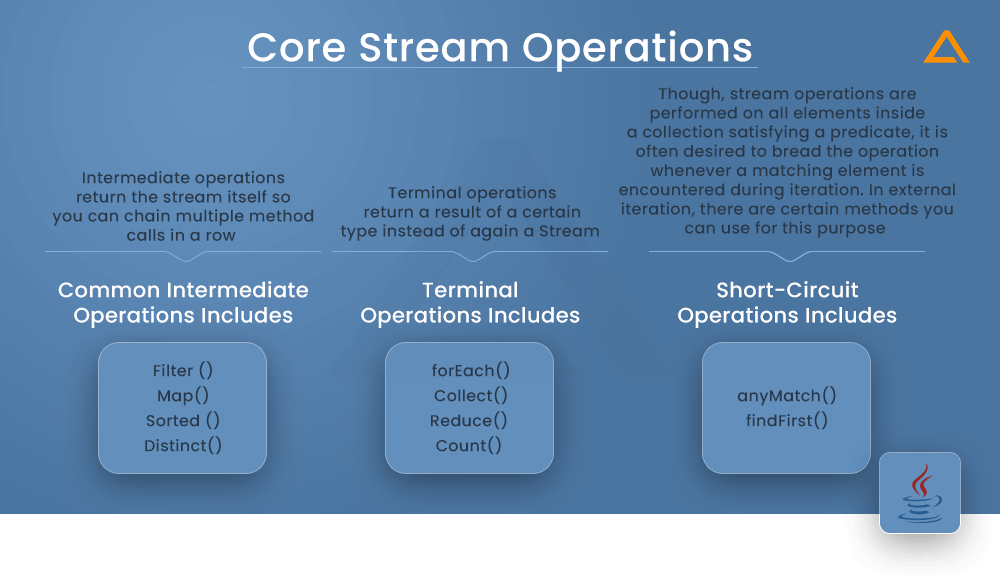
The Core Java Streams are broadly in 3 types of Java Stream operations namely as follow as depicted from the image shown.
Intermediate Operations
Intermediate Operations convert one stream into another stream. Some common intermediate operations include:
Filter()
The filter() action is used to select objects depending on a certain circumstance, from a stream. It takes a Predicate as an argument, which defines a condition to be applied to each element. Elements that match the predicate are retained in the stream, and those that do not match the predicate are excluded.
Syntax
Stream filter(Predicate predicate)Example
Stream intStream = Stream.of(6, 7, 8, 9, 10);
Stream subStream = intStream.filter(value -> value > 8);
long count = subStream.count();
System.out.println(count);Output
7Map()
Each element of the stream is converted to a new value using the map() function. It takes a Function as an argument, which determines how each element is mapped to a new value. The result is a trickle of converted material.
Syntax
Stream map(Function mapper)Example
// map() Operation
Stream strStream = Stream.of("Welcome", "To", "java", "stream");
Stream subStream2 = strStream.map(string -> {
if (string == "java")
return "Java-Aglowid";
return string;
});
List welcomeList = subStream2.collect(Collectors.toList());
System.out.println(welcomeList);Output
[Welcome, To, Java-Aglowid, blog]Sorted()
The sorted() function is used to sort the elements of a stream based on the specified comparison. Returns a new stream of elements sorted in ascending order by default, or according to a comparison supplied as an argument
Syntax
Stream sorted()Example
// sort() Operation
fruitStream = Stream.of("Apple", "Mango", "Strawberry", "Banana");
Stream sortedStream = fruitStream.sorted();
sortedStream.forEach(name -> System.out.println(name));Output
Apple
Banana
Mango
StrawberryDistinct()
The distinct() function is used to separate duplicate objects from a stream. A new stream containing only the exact items is returned, and the duplicates are removed
Syntax
Stream distinct()Example
// distinct() Operation
Stream vegStream = Stream.of("Potato", "Tomato", "Onion", " Potato");
Stream distinctStream = vegStream.distinct();
distinctStream.forEach(name -> System.out.println(name));Output
Potato
Tomato
OnionTerminal Operations
Java Streams terminal operations mark the end of the stream processing pipeline. These operations consume the stream and produce a final result or side effect.
forEach()
This method performs an action on each element of the stream. This is useful for iterating through elements and potentially modifying external state based on each element. The forEach() method returns the void.
Syntax
stream.forEach(element -> {
// Perform action on each element
});Example
import java.util.ArrayList;
import java.util.List;
import java.util.Optional;
import java.util.stream.Stream;
public class Main {
public static void main(String[] args)
{
List stringList = new ArrayList<>();
stringList.add("Apple");
stringList.add("Strawberries");
stringList.add("Mango");
stringList.add("Banana");
Stream stream = stringList.stream();
stream.forEach( element -> { System.out.println(element); });
}
}Output
Apple
Strawberries
Mango
BananaCollect()
The internal iteration of elements is started by the Java Stream collect() method, which is a terminal operation that gathers the elements in the stream into a collection or other object.
Syntax
CollectionType result =stream.collect(Collectors.toCollection(CollectionType::new));Example
import java.util.ArrayList;
import java.util.List;
import java.util.stream.Collectors;
import java.util.stream.Stream;
public class Main {
public static void main(String[] args)
{
List stringList = new ArrayList();
stringList.add("Lily");
stringList.add("Rose");
stringList.add("Orchids");
stringList.add("Lavender");
stringList.add("Tulip");
Stream stream = stringList.stream();
List stringsAsUppercaseList = stream
.map(value -> value.toUpperCase())
.collect(Collectors.toList());
System.out.println(stringsAsUppercaseList);
}
}Output
[Lily, Rose, Orchids, Lavender, Tulip]Reduce()
Stream elements are reduced to a single value by using a function that combines two elements at a time. Useful for storing values or searching for summary statistics.
Syntax
Optional result = stream.reduce((accumulator, element) -> {
// Perform reduction operation
return accumulator + element; // Example: Summing up elements
});Example
import java.util.ArrayList;
import java.util.List;
import java.util.Optional;
import java.util.stream.Stream;
public class Main {
public static void main(String[] args)
{
List stringList = new ArrayList<>();
stringList.add("one");
stringList.add("two");
stringList.add("three");
stringList.add("one");
Stream stream = stringList.stream();
Optional reduced = stream.reduce((value, combinedValue) -> {
return combinedValue + " + " + value;
});
System.out.println(reduced.get());
}
}Output
one + three + two + one Count()
The Java Stream count() method is a terminal function that counts the elements in the Stream by starting an iteration of the elements.
Syntax
long count = stream.count();Example
import java.util.ArrayList;
import java.util.List;
import java.util.stream.Collectors;
import java.util.stream.Stream;
public class Main {
public static void main(String[] args)
{
List stringList = new ArrayList();
stringList.add("one");
stringList.add("two");
stringList.add("three");
stringList.add("four");
stringList.add("five");
stringList.add("six");
Stream stream = stringList.stream();
long coutElements = stream
.map(value -> value.toUpperCase())
.count();
System.out.println(coutElements);
}
}Output
6Short-Circuit Operations
A short-circuit function in Java Streams is a terminal function that can prematurely terminate the stream function under certain circumstances. Instead of processing the entire stream, this routine sequentially searches the stream components until a specific condition is satisfied or a result is obtained When the condition is satisfied, the routine returns a result occurs immediately, without processing the rest of the stream.
anyMatch()
Check if at least one element in the stream matches the given predicate. If any element satisfies the condition, the action returns true and stops processing other elements. Otherwise, it tests all objects and returns false.
Syntax
boolean anyMatch = stream.anyMatch(element -> condition);Example
List<String> names = Arrays.asList("Daniel", "Luca", "Alexi");
boolean hasNameStartingWithA = names.stream().anyMatch(name -> name.startsWith("A"));Output
Output (if any name starts with "A"):
hasNameStartingWithA = truefindFirst()
Returns the first element of the stream, if it exists. This process creates and returns a new short-circuit containing the first element encountered in stream processing. Once the results are obtained, it does not examine the rest of the river.
Syntax
Optional<T> firstElement = stream.findFirst();Example
List<Integer> numbers = Arrays.asList(5, 2, 8);
Optional<Integer> firstNumber = numbers.stream().findFirst();Output (assuming numbers list is not empty)
firstNumber = Optional(5) (contains the first element, 5)
Are you looking to hire Java Developers?
Our experienced Java developers @ Aglowid are here to fast-track your project with tailored solutions.
Commonly Used Java Stream Operations
Java Streams provide a powerful and concise way to process collected data. However, as you harness these capabilities, it’s important to consider the security implications of your data processing pipelines. Ensuring that your implementations adhere to Java security best practices can help safeguard sensitive information and prevent vulnerabilities.
With that in mind, let’s explore common Java Stream implementations that are foundational to both effective and secure data processing. Here is the breakdown:

Filtering
This function acts like a filter, allowing only elements matching a particular condition (defined by the Predicate interface) to proceed to the next stage of the pipeline. Suppose a set of names has been filtered for names beginning only in the alphabet “A”.
Mapping
This operation transforms each element in the stream into the new element of potentially different type. You provide a Function interface that defines the transformation logic. Think of it like applying a function to each element in list, such as converting all string in the uppercase.
Reducing
This function combines all the items in the stream into a single value. You provide a BinaryOperator interface for storing elements. Imagine using reduce to compute the sum of all the numbers in the list.
Sorting
Do you need data in a specific format? Use Sort with Comparator to define a sort order. This allows you to sort items alphabetically, numerically, or based on any custom meaning you desire. For example, sort products by price.
Collecting
This versatile routine assembles objects into new collections (such as List, Set, or Map). You provide a collector that determines how the elements are stored in the final collection. Imagine collating all the names from the list into a new Set to eliminate duplicates.
Flat Mapping
FlatMap comes in handy when dealing with nested collections (such as list of lists). It flattens these nested structures into a single element stream, providing a cleaner way to handle them. Imagine converting a list of numbers into a single stream containing all the individual numbers.
By optimizing these basic operations and chaining them together, you can create powerful Stream pipelines for a variety of data processing tasks. They provide a concise and readable way to work with compiled data in Java, and can lead to faster and more efficient code.
Java Stream Concepts
The introduction of Java Streams in Java 8 changed how developers presented data processing in their applications. Here’s a breakdown of the key concepts that make streams so powerful and useful.

Declarative Style
Unlike traditional loops who’s main focus is on “how” to manipulate the data, streams on the other hand take the declarative approach. But what does it mean? Declarative approach means you can specific “what” you want to do with your data and Streams handles the execution part. This helps in expressing the data logic more concisely leading to the clean & readable code.
Immutability
Streams encourage immutability, which is a fundamental principle of functional design. Streams do not change the original dataset they operate on. Instead, they are new collections that have been modified based on your actions. This prevents accidental changes to the original data and improves the maintainability of the code.
Lazy Evaluation
Stream operations generally use lazy evaluation, meaning they don’t trigger until absolutely necessary. This approach benefits larger datasets by avoiding unnecessary processing of irrelevant elements. Stream operations only activate when terminal operations, like counting elements, are required.
Parallel Processing
Java Streams can take advantage of having multiple cores on your machine for parallel processing. This can significantly improve performance in data-intensive operations, especially on large data sets. By using multiple threads, Stream can process objects simultaneously, potentially speeding up your calculations.
Composability
You can chain stream operations together to create complex data processing pipelines. This approach breaks down complex tasks into smaller, more manageable steps. Each function acts like a filter or transformer in the data stream, building to the desired result. This modular approach encourages code reading and maintenance.
By understanding these basic concepts, you will be well on your way to harnessing the power of Java Streams and writing more efficient, maintainable, and faster code for your Java applications.
How to Create Java Streams?
There are several ways to create Java Streams, depending on the source of your data:

From Collections
This is the most common Stream method. Many collections such as Lists, Sets, and Maps provide a stream() method that returns a Stream containing the contents of the collection.
List<String> names = Arrays.asList("Aranya", "Billy", "Charlie");
Stream<String> nameStream = names.stream();From Arrays
Java Streams can be created using Array in two ways:
- Using Fixed number of Elements
- Using Primitive Type Array
Let’s start with understanding fixed number of elements.
Using Steam.of()
You can create this stream with this method with fixed number of elements. Regardless of the data type—String or Int—the Stream.of() function can be used to create a stream from a predetermined number of elements.
String[] fruits = {"apple", "Mango", "Grapes"};
Stream fruitStream = Stream.of(fruits);
int[] numbers = {1, 2, 3, 4, 5};
IntStream numberStream = Stream.of(1, 2, 3); // Can also use Stream.of for primitive types directlyUsing Arrays.Stream()
This method is specifically used for the primitive type arrays (double[], int[]. Etc)
int[] num = {1, 2, 3, 4, 5};
IntStream numberStream = Arrays.stream(num);From Files
Java Streams can work very well for data processing in characters from text files. The Files class provides a lines() method for creating a Stream of lines from a given file path. Remember to handle the possibility of exceptional IO with the try-with-resources block.
try (Stream lines = Files.lines(Paths.get("information.txt"))) {
// Process each line of the file
} catch (IOException e) {
// Handle file access exceptions
}Using Stream.of() for Individual Elements
While uncommon, Stream.of() method can also be used to create a Stream from a small number of individual elements.
Stream<Integer> numberStream = Stream.of(30,40,50);Using Stream.generate() and Stream.iterate() for Infinite Streams
These techniques are used to create countless Streams that generate factors based on a provided good judgment. Be cautious while the use of them, as infinte Streams can lead to memory problems if not handled properly with terminal operations that restrict the range of elements processed.
Stream.generate()
This method takes a supplier interface that generates the element.
Stream.iterate()
This method takes a seed value, a function to generate the next element based on the previous one, and a predicate to determine when to stop iterating.
// Infinite Stream of random numbers (be wary of memory usage)
Stream RNumbers = Stream.generate(() -> (int) (Math.random() 100));
// Stream of even numbers starting from 2 and stopping at 20
Stream evenNumbers = Stream.iterate(2, i -> i + 2, i -> i <= 20);Having explored the various ways to create Java streams and leverage their power for concise and efficient data manipulation, let’s delve into some common pitfalls to be aware of when working with streams. By understanding these potential issues, you can ensure your stream operations run smoothly and avoid unexpected behavior.
What Are the Common Issues To Be Aware Of When Using Java Streams?
While Java Streams provide an elegant and powerful way to manage collections, there is a potential pitfall to watch out for. Navigating these challenges effectively requires a deep understanding of Java Streams, which underscores the importance of having skilled Java developers on your team. Understanding these common Java Stream pitfalls can help you avoid unexpected behavior and keep your streams running smoothly.
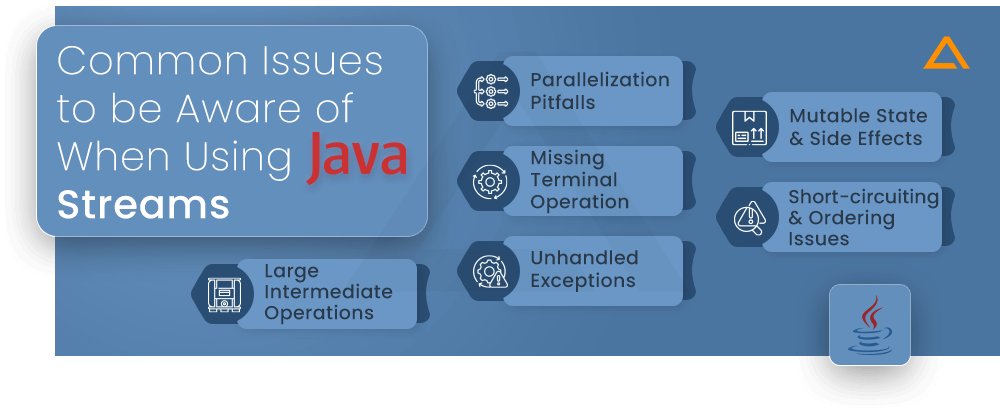
Here are some common issues to be aware of when using Java Streams:
Parallelization Pitfalls
The parallel streams can be a double-edged sword. While they offer performance benefits for big data, they can sometimes slow things down. Consider things like data sources (random access vs. sequential access) and the overhead from managing threads. Not all stream operations benefit from parallelization. Use your opinion and strategically determine when to compare.
Missing Terminal Operation
Streams use lazy evaluation, so operations don’t run until you call a terminal operation like a loop. If you forget the terminal operation, the stream won’t produce any output, and the processing steps won’t apply.
Mutable State and Side Effects
Streams follows practical design principles. Avoid changing shared state or introducing negative effects to your stream operations. This can lead to unpredictable behavior, especially in parallel streams.
Short-circuiting and Ordering Issues
Be aware of how short-circuiting functions such as findFirst or anyMatch can affect the use of the flow. Use appropriate methods or compilers to maintain the desired configuration in need of command.
Unhandled Exceptions
Exceptions thrown in lambda expressions used in stream functions can be difficult to catch. Ensure that appropriate exception handling procedures are in place to avoid abrupt program termination.
Large Intermediate Operations
Creating complex intermediate functions can lead to the creation of many intermediate data structures. This can cause memory usage issues, especially with large data sets. Consider upgrading your stream pipes to reduce unnecessary steps between them.
Now that you have an idea about which common pitfalls to be aware of, let’s see when to use Java Streams
When to use Java Streams?
- Streamline data transformations with map, filter & flatMap.
- Filter collections efficiently using conditions in the stream.
- Reduce boilerplate with built-in aggregation methods (sum, min, max etc.).
- Leverage parallel processing for large datasets (optional).
- Write clean, declarative code focusing on “what” not “how”.
Wrapping up!
Java Streams have become an important tool for data transformation in Java applications. They empower you to focus on what you want to achieve with your data by using a declarative approach, without getting stuck in how traditional loops work. This results in cleaner and more readable code.
Another significant benefit is lazy evaluation. Stream operations execute only when absolutely necessary, enhancing performance, particularly for large data sets.
In addition, Java Streams can leverage parallel processing capabilities on multi-core systems to speed up data processing tasks.
Whether you’re modifying, transforming, or summarizing collections, Java Streams provide a powerful and efficient way to solve your data challenges. By incorporating these concepts into your development workflow, you can write Java code that is concise, maintainable, and potentially faster.




